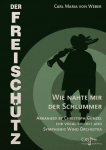Composer:
Sormani, Angelo Setting:
Concert Band
Genre:
Konzertstück • Originalwerk Type of Product:
Full Score • Stimmensatz Sator is a mysterious magic inscription, which can be found in many Italian and European locations. Initially, it was thought to be a Medieval invention; yet, many of these magic word squares were found in Mesopotamia, as well as Egypt, Cappadocia, and Britain, leading researchers to believe that while this symbolic square was used during the Middle Ages, its creation dates to an earlier period. The great majority of these squares was found in churches, abbeys, or venues belonging to the Medieval order of the Knights Templar, the Christian monks who, at the time of the Crusades, were the most skilled fighting units and became a military and spiritual model for the West. Their heroic deeds in the battles as well as their self-denial and dedication were exalted through all of Europe. The Knights Templar Order followed a well-defined hierarchical structure and, thanks to many donations, reached an unrivaled wealth during the Middle Ages. The symbol SATOR was seemingly used to mark particular venues, or to indicate secret hidden or even magical information. Sator Squares are still visible in Verona, in the court of the Benciolini Palace, in the Duomo S. Maria Assunta of Siena, in Fabriano, in the Trisulti Certosa of Frosinone, as well as in France at Saint Lorenzo in Rochemaure and in the castles of Chinon and Jarnac, and in Spain in the Saint James Cathedral of Compostela. The Magic Square is a palindromic phrase, “Rotas Opera Tenet Arepo Sator,” made up of five words, each with five letters, which can be read top-to-bottom, bottom-to-top, left-to-right, or right-to-left. There are many possible and conflicting meanings attributed to this phrase: it could be a symbol of fertility associated with the myth of Saturn, from the Romans Satus, representing the action of seeding, thus the word SATOR; it could be a disguised cross derived from the combinations of these words and thus a symbol used by early Christians to worship without signaling their presence; and last but not least there is a theory that the overlapping of the Star of David, or hexagram, with the word SATOR could give the key to solving this enigmatic inscription. The historical and mythological information, paired with its magical and mysterious meanings, have inspired this musical composition. Right from the start, the piece evokes the atmosphere of a medieval festival in the distance. As we approach, the confusing noises and sounds turn into simple rhythms and familiar melodies. Once at the party, we find knights, soldiers, and companions of many battles, and it is here that, among dances, laughter, and shouts, we hear many stories of brave deeds, last trips, and known places. During the party, the music changes character, alternating distinctly between rhythmic and melodic moments, while maintaining and developing the primary thematic idea throughout the whole composition.
The following options can be choosen to configure this product:



